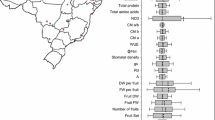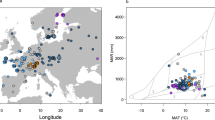Abstract
Atmospheric temperature is a key factor in determining the distribution of a plant species. Alongside this, plant populations growing at the margin of their range may exhibit traits that indicate genetic differentiation and adaptation to their local abiotic environment. We investigated whether geographically separated marginal populations of Arabidopsis lyrata ssp. petraea have distinct metabolic phenotypes associated with exposure to cold temperatures. Seeds of A. petraea were obtained from populations along a latitudinal gradient, namely Wales, Sweden and Iceland and grown in a controlled cabinet environment. Mannose, glucose, fructose, sucrose and raffinose concentrations were different between cold treatments and populations, especially in the Welsh population, but polyhydric alcohol concentrations were not. The free amino acid compositions were population specific, with fold differences in most amino acids, especially in the Icelandic populations, with gross changes in amino acids, particularly those associated with glutamine metabolism. Metabolic fingerprints and profiles were obtained. Principal component analysis (PCA) of metabolite fingerprints revealed metabolic characteristic phenotypes for each population and temperature. It is suggested that amino acids and carbohydrates were responsible for discriminating populations within the PCA. Metabolite fingerprinting and profiling has proved to be sufficiently sensitive to identify metabolic differences between plant populations at different atmospheric temperatures. These findings show that there is significant natural variation in cold metabolism among populations of A. l. petraea which may signify plant adaptation to local climates.




Similar content being viewed by others
References
Alonso-Blanco, C., Gomez-Mena, C., Llorente, F., Koornneef, M., Salinas, J., & Martı’nez-Zapater, J. M. (2005). Genetic and molecular analyses of natural variation indicate CBF2 as a candidate gene for underlying a freezing tolerance quantitative trait locus in Arabidopsis. Plant Physiology, 139, 1304–1312. doi:10.1104/pp.105.068510.
Atkin, O. K., Bruhn, D., Hurry, V. M., & Tjoelker, M. G. (2005). The hot and the cold: Unravelling the variable response of plant respiration to temperature. Functional Plant Biology, 32, 87–105. doi:10.1071/FP03176.
Bleeckerl, A. B., & Patterson, S. E. (1997). Last exit: Senescence, abscission, and meristem arrest in Arabidopsis. The Plant Cell, 9, 1169–1179. doi:10.1105/tpc.9.7.1169.
Clauss, M. J., & Koch, M. A. (2006). Poorly known relatives of Arabidopsis thaliana. Trends in Plant Science, 11, 449–459. doi:10.1016/j.tplants.2006.07.005.
Clauss, M. J., & Mitchell-Olds, T. (2006). Population genetic structure of Arabidopsis lyrata in Europe. Molecular Ecology, 15, 2753–2766.
Cook, D., Fowler, S., Fiehn, O., & Thomashaw, M. F. (2004). A prominent role for the CBF cold response pathway in configuring the low-temperature metabolome of Arabidopsis. Proceedings of the National Academy of Sciences of the United States of America, 101, 15243–15248. doi:10.1073/pnas.0406069101.
Coruzzi, G. M. (2003). Primary N-assimilation into amino acids in Arabidopsis. In C. R. Somerville & E. M. Meyerowitz (Eds.), The Arabidopsis book (pp. 1–17). Maryland: American society of Plant Biologists.
Davey, M. P., Burrell, M. M., Woodward, F. I., & Quick, W. P. (2008). Population-specific metabolic phenotypes of Arabidopsis lyrata ssp. petraea. The New Phytologist, 177, 380–388.
Gray, G. R., & Heath, D. (2005). A global reorganization of the metabolome in Arabidopsis during cold acclimation is revealed by metabolic fingerprinting. Physiologia Plantarum, 124, 236–248. doi:10.1111/j.1399-3054.2005.00507.x.
Guy, C. L., Huber, J. L. A., & Huber, S. C. (1992). Sucrose phosphate synthase and sucrose accumulation at low temperature. Plant Physiology, 100, 502–508.
Hannah, M. A., Wiese, D., Freund, S., Fiehn, O., Heyer, A. G., & Hincha, D. K. (2006). Natural genetic variation of freezing tolerance in Arabidopsis thaliana. Plant Physiology, 142, 98–112. doi:10.1104/pp.106.081141.
Jonsell, B., Kustås, K., & Nordal, I. (1995). Genetic variation in Arabis petraea, a disjunct species in northern Europe. Ecography, 18, 321–332. doi:10.1111/j.1600-0587.1995.tb00135.x.
Kaplan, F., Kopka, J., Haskell, D. W., et al. (2004). Exploring the temperature-stress metabolome of Arabidopsis. Plant Physiology, 136, 4159–4168. doi:10.1104/pp.104.052142.
Kaplan, F., Kopka, J., Sung, D. Y., et al. (2007). Transcript and metabolite profiling during cold acclimation of Arabidopsis reveals an intricate relationship of cold-regulated gene expression with modifications in metabolite content. The Plant Journal, 50, 967–981. doi:10.1111/j.1365-313X.2007.03100.x.
Kilian, J., Whitehead, D., Horak, J., et al. (2007). The AtGenExpress global stress expression data set: Protocols, evaluation and model data analysis of UV-B light, drought and cold stress responses. The Plant Journal, 50, 347–363. doi:10.1111/j.1365-313X.2007.03052.x.
Klotke, J., Kopka, J., Gatzke, N., & Heyer, A. G. (2004). Impact of soluble sugar concentrations on the acquisition of freezing tolerance in accessions of Arabidopsis thaliana with contrasting cold acclimation––evidence for a role of raffinose in cold acclimation. Plant Cell & Environment, 27, 1395–1404. doi:10.1111/j.1365-3040.2004.01242.x.
Lam, H. M., Coschigano, K., Schultz, C., et al. (1995). Use of Arabidopsis mutants and genes to study amide amino acid biosynthesis. The Plant Cell, 7, 887–898.
Lam, H. M., Hsieh, M. H., & Coruzzi, G. (1998). Reciprocal regulation of distinct asparagine synthetase genes by light and metabolites in Arabidopsis thaliana. The Plant Journal, 16, 345–353. doi:10.1046/j.1365-313x.1998.00302.x.
Lam, H. M., Peng, S. S. Y., & Coruzzi, G. M. (1994). Metabolic regulation of the gene encoding glutamine-dependent asparagine synthetase in Arabidopsis thaliana. Plant Physiology, 106, 1347–1357. doi:10.1104/pp.106.4.1347.
Li, R. J., Hua, W., & Lu, Y. T. (2006). Arabidopsis cytosolic glutamine synthetase AtGLN1;1 is a potential substrate of AtCRK3 involved in leaf senescence. Biochemical and Biophysical Research Communications, 342, 119–126. doi:10.1016/j.bbrc.2006.01.100.
Meyer, R. C., Steinfath, M., Lisec, J., et al. (2007). The metabolic signature related to high plant growth rate in Arabidopsis thaliana. Proceedings of the National Academy of Sciences of the United States of America, 104, 4759–4764. doi:10.1073/pnas.0609709104.
Miesak, B. H., & Coruzzi, G. M. (2002). Molecular and physiological analysis of Arabidopsis mutants defective in cytosolic or chloroplastic aspartate aminotransferase. Plant Physiology, 129, 650–660. doi:10.1104/pp.005090.
Oliveira, I. C., & Coruzzi, G. M. (1999). Carbon and amino acids reciprocally modulate the expression of glutamine synthetase in Arabidopsis. Plant Physiology, 121, 301–309. doi:10.1104/pp.121.1.301.
Peterman, T. K., & Goodman, H. M. (1991). The glutamine synthetase gene family of Arabidopsis thaliana: Light-regulation and differential expression in leaves, roots and seeds. Molecular & General Genetics, 230, 145–154. doi:10.1007/BF00290662.
Sackville Hamilton, N. R., Skøt, L., Chorlton, K. H., Thomas, I. D., & Mizen, S. (2002). Molecular genecology of temperature response in Lolium perenne: 1 preliminary analysis to reduce false positives. Molecular Ecology, 11, 1855–1863. doi:10.1046/j.1365-294X.2002.01567.x.
Sagisaka, S., & Araki, T. (1983). Amino acid pools in perennial plants at the wintering stage and at the beginning of growth. Plant & Cell Physiology, 24, 479–494.
Skøt, L., Sackville Hamilton, N. R., Mizen, S., Chorlton, K. H., & Thomas, I. D. (2002). Molecular genecology of temperature response in Lolium perenne: 2 Association of AFLP markers with ecogeography. Molecular Ecology, 11, 1865–1876. doi:10.1046/j.1365-294X.2002.01568.x.
Smirnoff, N. (1998). Plant resistance to environmental stress. Current Opinion in Biotechnology, 9, 11–29. doi:10.1016/S0958-1669(98)80118-3.
Stitt, M., & Hurry, V. (2002). A plant for all seasons: Alterations in photosynthetic carbon metabolism during cold acclimation in Arabidopsis. Current Opinion in Plant Biology, 5, 199–206. doi:10.1016/S1369-5266(02)00258-3.
Strand, Å., Hurry, V., Henkes, S., et al. (1999). Acclimation of Arabidopsis leaves developing at low temperatures increasing cytoplasmic volume accompanies increased activities of enzymes in the Calvin cycle and in the sucrose-biosynthesis pathway. The Plant Journal, 12, 605–614. doi:10.1046/j.1365-313X.1997.00605.x.
Suzuki, A., & Knaff, D. B. (2005). Glutamate synthase: Structural, mechanistic and regulatory properties and role in the amino acid metabolism. Photosynthesis Research, 83, 191–217. doi:10.1007/s11120-004-3478-0.
Thomas, C. D., Cameron, A., Green, R. E., et al. (2004). Extinction risk from climate change. Nature, 427, 145–148. doi:10.1038/nature02121.
Thomashow, M. F. (1999). Plant cold acclimation: Freezing tolerance genes and regulatory mechanisms. Annual Review of Plant Physiology and Molecular Biololgy, 50, 571–599. doi:10.1146/annurev.arplant.50.1.571.
Usadel, B., Bläsing, O. E., Gibon, Y., et al. (2008). Multilevel genomic analysis of the response of transcripts enzyme activities and metabolites in Arabidopsis rosettes to a progressive decrease of temperature in the non-freezing range. Plant Cell & Environment, 31, 518–547. doi:10.1111/j.1365-3040.2007.01763.x.
Vergeer, P., van den Berg, L. L. J., Bulling, M. T., Ashmore, M. R., & Kunin, W. E. (2008). Geographical variation in the response to nitrogen deposition in Arabidopsis lyrata petraea. The New Phytologist, 179(1), 129–141. doi:10.1111/j.1469-8137.2008.02445.x.
Vinocur, B., & Altman, A. (2005). Recent advances in engineering plant tolerance to abiotic stress: Achievements and limitations. Current Opinion in Biotechnology, 16, 123–132. doi:10.1016/j.copbio.2005.02.001.
Walther, G. R., Berger, S., & Sykes, M. T. (2005). An ecological ‘footprint’ of climate change. Proceedings of the Royal Society of London. Series B. Biological Sciences, 272, 1427–1432. doi:10.1098/rspb.2005.3119.
Walther, G. R., Post, E., Convey, P., et al. (2002). Ecological responses to recent climate change. Nature, 416, 389–395. doi:10.1038/416389a.
Zhen, Y., & Ungerer, M. C. (2008). Clinal variation in freezing tolerance among natural accessions of Arabidopsis thaliana. The New Phytologist, 177, 419–427.
Acknowledgements
This research was funded by the Natural Environment Research Council Post-Genomics and Proteomics programme (NE/C507837/1). We thank D. Kinsman, J. Keily, J. Ramsden, H. Walker and M. Wormald for analytical help. We thank Dr. S. Ansell, Dr. W.E. Kunin, Dr. J.A. Lake, Dr. B. Lomax and Dr. P. Vergeer for seed collection and Dr. C. Lilley and Dr. N. Haigh at the University of Leeds for gene expression data.
Author information
Authors and Affiliations
Corresponding author
Electronic supplementary material
Below is the link to the electronic supplementary material.
Rights and permissions
About this article
Cite this article
Davey, M.P., Ian Woodward, F. & Paul Quick, W. Intraspecfic variation in cold-temperature metabolic phenotypes of Arabidopsis lyrata ssp. petraea . Metabolomics 5, 138–149 (2009). https://doi.org/10.1007/s11306-008-0127-1
Received:
Accepted:
Published:
Issue Date:
DOI: https://doi.org/10.1007/s11306-008-0127-1




